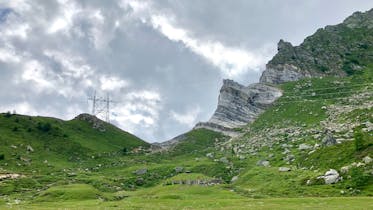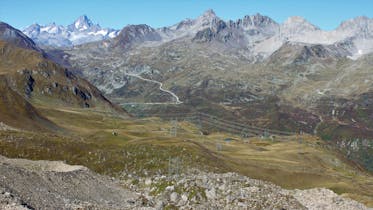Airolo – Lavorgo Grid project All'Acqua – Maggia – Magadino

Travelling by train, charging an electric vehicle or even just switching on the light at home: what appears to be a given today is actually the result of a series of complex processes along the way from the generation to the consumption of energy. Bringing electricity to our homes requires a tightly interconnected grid not unlike a dense network of roads and highways.
Constructing these «roads» for our electricity is anything but easy, however, and frequently triggers strong emotions in the residents affected. Even if nobody doubts the benefit and necessity of such maintenance and modernisation work, the construction of infrastructure such as highways, rail routes or power lines always prompts fierce reactions among the population, resulting in many oppositions. Such debates generally centre around where to build these connections that are so vital to Switzerland. In an area as densely populated as Switzerland, it seems it is becoming ever more difficult to find space for new infrastructure. Is there a solution to this problem? Swissgrid believes there is. It involves dialogue and synergies, and these are precisely what forms the basis of Ticino’s Studio Generale initiative. The initiative was launched by the canton in 2013 and is intended to be an innovative approach that brings together Swissgrid, SBB and Azienda Elettrica Ticinese (AET) with the aim of realising future power line projects that are optimally coordinated with regional planning. In this series of blogs, we team up with the partners involved to reflect on the collaboration and take a look ahead at the next phases. In the first blog, Philippe Meuli, Grid Program Manager, tells us why he had faith in the project from the start.
Philippe Meuli, Swissgrid took over the Swiss transmission grid back in 2013. How did the contact with the canton initially come about?
The Canton of Ticino, Swissgrid, SBB and AET have been working together since late 2013 on developing a concept for reorganising power lines at the cantonal level.
The collaboration began in 2012 as part of the consultation on the Airolo – Lavorgo corridor, when the canton expressed a desire to evaluate this corridor as part of an overall vision for Alto Ticino. This proposal made even more sense because, from 2013 onwards, Swissgrid was to take over responsibility for planning, expanding, operating and funding the entire Swiss extra-high-voltage grid.
What exactly is Studio Generale? What are the advantages and challenges for Swissgrid?
In agreement with the Swiss Federal Office of Energy (SFOE), the Canton of Ticino, AET, SBB and Swissgrid all signed a declaration of intent, which paved the way for a general study on the high-voltage and extra-high-voltage grids in Ticino. The aim is to develop a comprehensive and long-term vision at a cantonal level and to coordinate the objectives for modernising and expanding power lines with the objectives of regional planning.
Swissgrid’s objectives for the extra-high-voltage grid are to:
- Guarantee the security of supply south of the Alps well into the future
- Transport electrical energy generated from hydropower
- Increase the transport capacity between Switzerland and Italy
- Optimise usage of the existing infrastructure
- Limit the number and length of the new lines
- Erect the necessary new installations in due time
- Limit costs
How do you rate the collaboration with the other partners (AET, SBB and the canton)?
The collaboration is very good. Taking into account the interests of all participants, we are working together to develop proposals for determining the future corridors for the electrical infrastructure. That covers Swissgrid’s extra-high-voltage electrical lines, AET’s distribution grid lines and SBB’s railway power lines within one «gruppo operativo» (working group).
Wherever possible, efforts will be made to examine and consider the possibility of combining the different parts of the electrical infrastructure with other infrastructure lines such as roads and railways.
The proposals developed are reviewed and approved by the «direzione strategica» (steering committee). The canton incorporates the results into its «piano direttore» (structure plan), and the organisations involved then take them into consideration in their medium- to long-term planning for the renewal of the grid. This way, the canton’s regional planning interests are brought into harmony with the modernisation, expansion and renewal needs of the grid operators – for a shared future.
What have been the successes of the initiative thus far?
The initiative has already started to bear fruit. The first phase, which was concluded in 2015 and involved an examination of the Leventina and Maggia Valley areas, produced some impressive results: the renewal and optimisation of the extra-high-voltage line through the Maggia Valley; the reinforcement of the extra-high-voltage line in the Leventina; and thus ultimately the dismantling of more than 60 km of extra-high-voltage lines.
The project benefits the landscape most of all
Are there hopes that this study will help to speed up the approval process?
The benefit of the study is that the plan is oriented towards the long term and is set out in the «piano direttore» for the Canton of Ticino. The fact that the results of the Studio Generale were and continue to be discussed with the relevant federal authorities will undoubtedly help with the forthcoming sectoral planning and the planning approval procedure.
Another specific example is the All’Acqua – Magadino project. Here, Swissgrid needs to replace the outdated transmission lines. Thanks to Studio Generale, a solution was found that enables the dismantling of more than 60 km of extra-high-voltage lines between the Maggia Valley and Leventina, since the new project renders them obsolete. Furthermore, the increased transfer capacity means the limitations on generation by the hydropower plants in the Maggia Valley will no longer be necessary. Alongside the economic advantages, however, the project benefits the landscape most of all, since some of the current lines run through settlements or areas of national importance such as Campolungo.
We can also assume it will be possible to proceed with sectoral plans more quickly for planned future projects, since the necessary basis has already been agreed with the canton and the other grid operators and set out in the «piano direttore».
Can this collaboration serve as an example for similar projects in other cantons?
I would be delighted if all cantons followed the example of the Canton of Ticino and worked together with other infrastructure operators to plan the bundling of linear infrastructure. The results would then be incorporated into the cantonal structural plan. This would give the relevant infrastructure operators greater planning security for future projects, and the needs of the infrastructure operators would be aligned with the regional planning interests of the confederation and the cantons.
Next steps
After the initial success with phase one, work has been underway on the second planning stage of the study since 2017. This stage poses an even bigger challenge because of the very large area to be examined, which stretches all the way from the Bassa Leventina, via the Blenio Valley, Riviera, and the Magadino Plain,to Manno. The results will be published during the course of 2021.
In the second part of the blog series, Paolo Poggiati will present the canton’s point of view.









